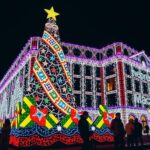The exhibition “transfeminisms” at Mimosa House in London redefines feminist art by incorporating global perspectives on gender, resistance, and activism through five thematic chapters, culminating in a focus on the often-hidden labours of the queer community. Curated by Maura Reilly and others, it highlights the complexity of feminist narratives today.
In 2007, the Brooklyn Museum hosted “Global Feminisms,” an influential exhibition showcasing feminist art from a global perspective. Curated by Maura Reilly and Linda Nochlin, it contrasted Western-centric views of feminism. Sixteen years later, the ongoing exhibition “transfeminisms,” curated by Reilly with Christine Eyene, Daria Khan, and Jennifer McCabe at London’s Mimosa House, expands upon this foundation, exploring inclusivity across various dimensions of gender, geography, and subject matter. “Transfeminisms” is organised into five thematic chapters. The first chapter, “Activism and Resistance,” highlighted political protest through art, addressing issues such as free speech and state violence. Notable works included Bahia Shehab’s “A Thousand Times No,” which responds to Palestinian genocide, and various pieces tackling historical narratives and societal repression. Chapter II, “Radical Imagination,” reimagined mythological and religious icons through a feminist lens, with works like Martine Gutierrez’s photography series challenging traditional narratives of femininity. The third chapter, “Fragile Archives,” focused on alternative histories and personal narratives, showcasing artists who redefine traditional storytelling beyond institutional confines. Chapter IV, “Care and Kinship,” emphasised ancestral connections and rituals, celebrating previous generations’ contributions to feminism through artists like Sonia Boyce. The culmination of the exhibition, Chapter V, entitled “Hidden Labours,” examines the often invisible work of the queer community, confronting issues of gendered labour and visibility through various artistic mediums. Overall, “transfeminisms” represents a significant evolution in feminist art discourse, encouraging dialogue on resilience and resistance across global narratives while honouring diverse experiences.
The rise of transfeminism is rooted in the need to address intersectionality within feminist discourse, incorporating perspectives from various cultures and communities. Since the 2007 Brooklyn Museum exhibition, the feminist art landscape has broadened, reflecting debates around decolonisation, reproductive rights, and climate activism. The new exhibition at Mimosa House builds upon this evolution by uniting a diverse array of voices and perspectives in contemporary feminist art, spotlighting the complexities of gender identity and representation.
In summary, “transfeminisms” at Mimosa House showcases a rich tapestry of feminist art that engages with contemporary global issues. Through its exploration of activism, radical imagination, fragile histories, care, and hidden labours, the exhibition drives critical conversations about resistance and the nuances of gender and identity in the 21st century. As it progresses to its final chapter, it underscores the ongoing importance of inclusivity in feminist practices.
Original Source: www.dazeddigital.com






